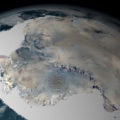
Global warming and changing climatic conditions are triggering disease epidemics in wildlife around the world, reports a renowned team of ecologists and epidemiologists in the Friday June 21st issue of Science. The outbreaks are occurring in habitats ranging from coral reefs to rainforests. This comprehensive two year study coming out of the National Center for Ecological Analysis and Synthesis (NCEAS) is the first to analyze disease epidemics across entire plant and animal systems, both on land and in the oceans. The study investigates these recent disease outbreaks and examines the mechanisms related to temperature or seasonality changes that could influence them. “What is most surprising is the fact that climate sensitive outbreaks are happening with so many different types of pathogens – viruses, bacteria, fungi, and parasites – as well as in such a wide range of hosts including corals, oysters, terrestrial plants, birds, and humans,” says lead author Drew Harvell of Cornell University.
“This isn’t just a question of coral bleaching for a few marine ecologists, nor just a question of malaria for a few health officials – the number of similar increases in disease incidence is astonishing,” says coauthor Richard Ostfeld from the Institute of Ecosystem Studies in Millbrook New York. “We don’t want to be alarmist, but we are alarmed.”
The team documented examples of viruses, bacteria, and fungi associated with diseases that develop more rapidly with slight rises in temperature. Many vectors of disease such as mosquitoes, ticks, and rodents, as well as the viral, fungal, and bacterial pathogens are highly temperature and moisture sensitive. As temperatures increase, these carriers are likely to spread into new areas and may have potentially devastating effects on wildlife populations that have not been previously exposed. Reproduction, growth, and biting rates of insects all go up with increases of temperature. Winter is the limiting time for many pathogens, killing back populations each year. With milder winters, this population bottleneck may be removed for many species. Warmer, longer summers also mean that the period of time of disease transmission is longer. Warmer summers may increase host susceptibility to diseases due to thermal stress, particularly in the oceans. Marine bacteria and fungal growth rates are positively correlated with increasing temperature.
Some examples of disease outbreaks and their climate related links include:
- In the Hawaiian Islands, mosquitoes are chewing their ways into the last populations of honeycreepers – boldly colored songbirds that evolved only in Hawaii. In the 1960’s mosquitoes were restricted by temperature to elevations below 2,500 feet, but warmer temperatures have allowed them to move higher up the mountainsides. With the mosquitoes has come the spread of avian malaria to native bird populations. “Today there are no native birds below 4,500 feet,” says Andrew Dobson. Now the honeycreepers are mostly restricted to the highest forested slopes of the Big Island of Hawaii and Maui at elevations cool enough to stop the mosquitoes.
- Rift Valley Fever, a devastating viral illness spread by mosquitoes occurs particularly in parts of East Africa and is strongly linked to heavy rains. “There is clear evidence that Rift Valley Fever outbreaks are linked to El Niño years and we expect an increase in the frequency of El Niños with climate change,” states coauthor Richard Ostfeld. The last outbreak in 1998 killed thousands in East Africa. In the wetter conditions mosquito populations explode, more mosquitoes acquire the disease, and more transmit the disease to humans and livestock. With warmer conditions we expect both faster replication of the virus within mosquitoes and an increase in the rate that they bite and infect other animals.
- Corals are the canary in the coalmine for global warming. During the unusually warm 1998 El Niño year, corals suffered massive die-offs worldwide. Now, a new large bleaching event has just occurred in Australia. Harvell and other scientists have shown that once bleached or stressed by heat, some corals become susceptible to disease. “The disease may be what actually kills them,” says Harvell. Harvell and colleagues attribute a dieback of the dominant soft corals in the Caribbean called sea fans to a fungal epidemic. Aspergillis (a fungus that occurs everywhere) tends to be a pathogen of immune compromised hosts. “Once stressed, corals become susceptible to diseases,” says Harvell whose group has isolated the fungus and found that it grows fastest at 30-32 degrees Celsius – exactly the temperature at which many of the corals in the Florida Keys start to bleach.
- Warming winter temperatures can be as significant as rising summer temperatures in affecting ranges of pathogens and parasites. The edible eastern oyster is plagued by a protozoan parasite called Perkinsus. A winter warming trend in the mid 1990’s lifted a barrier to northward movement and allowed this parasite to spread northward into previously unexposed Maine oysters.
“The diseases we should be most worried about are the vector transmitted diseases,” says Dobson. As temperature warms, insects carrying disease from the tropics are spreading towards the poles. In tropical areas, there is a greater diversity of species, but smaller numbers of individuals of each. This dilutes the spread of pathogens between species.
In temperate areas, disease can hit harder. There are fewer numbers of species but many more individuals, making them more vulnerable to epidemics. With higher levels of biodiversity, there is a greater chance that a mosquito will bite a species in which the disease doesn’t develop. In temperate areas, vectors have fewer choices about what to bite. As biodiversity decreases there is less and less buffering. “Thus any pathogen which manages to spread from the tropics to the temperate zone in a warmer world is likely to have a bigger impact as it can focus on a few common and abundant susceptible species�maybe even us!” says Dobson.
Pathogens have also contributed to declines of threatened species such as lions, cranes, vultures, and black-footed ferrets, among others. “Human destruction of biodiversity makes this a double whammy – it means we are exacerbating the problem,” says Dobson.
The authors acknowledge that response to their findings will be controversial and politicized. “There are still people resistant to the idea of climate change at all, others will say it is hard to predict what type of outbreaks will occur or where they will happen,” says Dobson. “This is true. Very little monitoring and few long-term studies exist. What is apparent is the end result – when the epidemic strikes.” When they do, little is known about how to respond – and that needs to change say the authors.
Baseline disease data are critical. And while forecasting epidemics in crop diseases has received much attention, and the National Ocean and Atmospheric Administration (NOAA) has a sea surface temperature monitoring system for coral bleaching, there are no disease forecasting models for threatened wildlife populations or management protocols for infectious diseases.
“We need to develop lines of defense,” says Harvell. “Now that we know these epidemics are arising, what can we do about it? It’s highly likely to get worse with increasing temperature.”
Besides HIV funding, there is very little research money going towards infectious disease work and training. “The scary thing about the recent anthrax threat was not just that it happened but how few people know anything about infectious diseases, and how little even these people know about their dynamics,” says Dobson. “We need to pay better attention to this issue in an increasingly unnatural world.” To improve our ability to predict epidemics in wild populations, it will be necessary to separate the independent and interactive effects of numerous climate related influences on diseases. Development of disease protocols in response to break outs are essential.
“We have to get serious about global change,” says Dobson. “It’s not only going to be a warmer world, it’s going to be a sicker world.”

















Comments are closed.